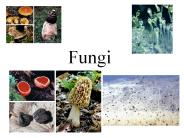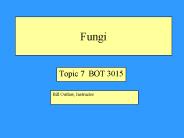Fungi PowerPoint PPT Presentations
All Time
Recommended
1-56 of over 5,000
Fungi - Introduction to the Fungi, Ecological Impacts of Fungi, and Phylogenetic Relationships of Fungi
| PowerPoint PPT presentation | free to view
The Fungi Kingdom Mycology - the study of fungi fungi - singular fungus - plural 4 Main Characteristics of Fungi 1) fungi are eukaryotic they have a nuclei & mitochondria
| PowerPoint PPT presentation | free to view
Fungi vs. 'fungi' Based on the phenotypic definitions or traits attributed to ... Nomenclature. Introductory Mycology BOT 461/561. http://ocid.nacse.org ...
| PowerPoint PPT presentation | free to view
Title: No Slide Title Author: Spatafora Last modified by: Joseph Spatafora Created Date: 10/7/2002 4:07:41 AM Document presentation format: On-screen Show
| PowerPoint PPT presentation | free to view
inoperculate zoosporangia discharge zoospores through ... most known species possess inoperculate zoosporangia. Sexual reproduction ...
| PowerPoint PPT presentation | free to view
Zoosporic fungi: Chytridiomycota Kingdom Fungi Chytridiomycota & Zygomycota sometimes referred to as lower fungi formerly classified in the Phycomycetes = algal ...
| PowerPoint PPT presentation | free to view
Introduction to the Fungi and Fungal Ecology
| PowerPoint PPT presentation | free to view
Candidiasis - an infection caused by a Candida spp. Candida is a yeast and is is part of the normal flora ... in opportunistic mycoses (following Candida spp) ...
| PowerPoint PPT presentation | free to download
... of advanced decay include cavities, open cracks, and holes in the wood. Tree Risk Categories ... Separation of the wood or a deep split through the bark ...
| PowerPoint PPT presentation | free to view
Figure 31.0 Painting of indigo milk cap (Lactarius indigo) fungus as an example ... Figure 31.2x Septate hyphae (left) and nonseptate hyphae (right) ...
| PowerPoint PPT presentation | free to view
Azotobacter vinelandii Schizosaccharomyces pombe Burkholderia mallei Acidovorax avenae Coprinopsis cinerea okayama 100 SmGSTH2 Oryza sativa Populus trichocarpa
| PowerPoint PPT presentation | free to download
Serratia proteamaculans Algae Sinorhizobium meliloti Agrobacterium radiobacter Sinorhizobium medicae Sinorhizobium fredii Agrobacterium vitis Bacteria Bacteria 0.2
| PowerPoint PPT presentation | free to download
A brief description about fungi
| PowerPoint PPT presentation | free to download
Fungi Chapter 31 * Figure 31.17c Basidiomycetes (club fungi) (part 3: maiden veil fungus) Parasitic Mycosis Fungal infection Ringworm Athlete s foot Candida ...
| PowerPoint PPT presentation | free to download
PowerPoint Presentation ... Fungi
| PowerPoint PPT presentation | free to download
FUNGI Chapter 21 Clusters of mushrooms are often part of the same mycelium, which means they are the same organism * Section 1 The Kingdom Fungi What are Fungi?
| PowerPoint PPT presentation | free to view
FUNGI Chapter 21 Clusters of mushrooms are often part of the same mycelium, which means they are the same organism * Section 1 The Kingdom Fungi What are Fungi?
| PowerPoint PPT presentation | free to download
... Produces the antibiotic penicillin Deuteromycetes can cause skin diseases such as athlete s foot Fungi Plants ... fungal crop diseases ... disease in humans ...
| PowerPoint PPT presentation | free to view
FUNGI Fungi Kingdom Eukaryotes. Use spores to reproduce. Heterotrophs cannot make their own food. Need warm, moist places to grow. Examples: yeast, molds and mushrooms.
| PowerPoint PPT presentation | free to view
FUNGI What do you know about fungi? General Characteristics Multi-cellular and eukaryotic Heterotrophs Saprophytes, parasites, symbionts, decomposers Releases ...
| PowerPoint PPT presentation | free to view
FUNGI Wow! Fungi plant growth - The Private Life of Plants - David Attenborough - BBC wildlife - YouTube Fungi Structure & Function hyphae: chitin mycelium fruiting ...
| PowerPoint PPT presentation | free to view
Fungi Basic Information: Fungi are... - eukaryotes - mostly multicellular - sometimes unicellular (yeast) - very diverse with an estimated 1.5 million species ...
| PowerPoint PPT presentation | free to view
Title: Wednesday, September 5 Author: Peter Last modified by: Peter Created Date: 8/16/2006 12:00:00 AM Document presentation format: On-screen Show (4:3)
| PowerPoint PPT presentation | free to download
Fungi Chapter 19 Se ora Ettinger Answer these questions: How do fungi differ from other organisms? How does the lifestyle of a fungus enable it to obtain food?
| PowerPoint PPT presentation | free to view
FUNGI An Overview Characteristics of Fungi Eukaryotic Nonphotosynthetic ( heterotrophic) Most are multicellular Most are microscopic molds or yeasts The study fungi ...
| PowerPoint PPT presentation | free to view
... Mat of hyphae = mycelium Histoplasma capsulatum Able to change form in response to changes in environment Grows as mycelium on ground Invades human: ...
| PowerPoint PPT presentation | free to view
Title: PowerPoint Presentation - I. Introduction to class Author: Multimedia Development Lab Last modified by: puneet kaushik Created Date: 6/17/1995 11:31:02 PM
| PowerPoint PPT presentation | free to download
Locomotion of the Mushroom Mushrooms can only move by spreading over acres of land by growing. ... Mushrooms Some mushrooms boast cancer fighting properties.
| PowerPoint PPT presentation | free to view
Introduction Fungi Fungus Mycology Mykes = Mushroom Medical mycology 5 kingdom Monera Plant Animal Fungi Protista Eukaryote & Heterotrophic Structure & Ultra ...
| PowerPoint PPT presentation | free to download
Fungi Chapter 31 Fungi Characteristics Despite their diversity fungi share some key traits: Fungi are heterotrophs but do not ingest their food Fungi secrete ...
| PowerPoint PPT presentation | free to view
Fungi Starr/Taggart s Biology: The Unity and Diversity of Life, 9e Chapter 24 Key Concepts: Fungi are heterotrophs Fungi and bacteria are the decomposers of the ...
| PowerPoint PPT presentation | free to view
Fungi Eukaryotes (have cell walls) Hyphae- threadlike tubes that make up the bodies of multicellular fungi. (pg. 479) Where are they Found? Fungi need warm moist ...
| PowerPoint PPT presentation | free to download
Fungi Characteristics Multicellular (few exceptions like yeast) Eukaryotic Heterotrophic, break down food then absorb, saprotrophic Some are parasitic, cause disease ...
| PowerPoint PPT presentation | free to download
Fungi When you think of fungus, what do you think of? Mold on your fruits? Mushrooms on your Pizza? * * Importance of Kingdom Fungi 1. many pathogenic species ex ...
| PowerPoint PPT presentation | free to download
... and animals (athlete's foot, ringworm) FUNGI. OVERVIEW ... foot & ringworm ... are actually human pathogens causing athlete's foot and ringworm ...
| PowerPoint PPT presentation | free to view
Fungi & Systemic Mycoses Alfred Lewin References http://www.doctorfungus.org/ Schaechter et al. Mechanisms of Microbial Disease Kobayashi et al. Medical Microbiology
| PowerPoint PPT presentation | free to download
Fungi 1 Fungi Basics Yeasts are single-celled fungi, so they are microbes. So is mould. Fungi are usually bigger than bacteria. If there is just one of them, we call ...
| PowerPoint PPT presentation | free to download
Fungi & Systemic Mycoses Alfred Lewin References http://www.doctorfungus.org/ Schaechter et al. Mechanisms of Microbial Disease Kobayashi et al. Medical Microbiology
| PowerPoint PPT presentation | free to download
Fungi secrete powerful enzymes that digest food ... Basidiomycota-mushrooms, toadstools, puffballs. Sporangium is club-shaped (basidium) ... Poisonous toadstool ...
| PowerPoint PPT presentation | free to view
Can grow in damp places like a shower curtain. Scientists are not sure how fungi are related to ... Produce spores in a small, saclike structure called an ascus ...
| PowerPoint PPT presentation | free to view
Fungi are capable of both sexual and asexual reproduction. ... may form from asexual or sexual processes ... most reproduction is asexual and takes place by ...
| PowerPoint PPT presentation | free to view
Hyphae grow from their tips. Mycelium = extensive, feeding web of hyphae ... Grow rapidly. Fig 31.6 Rhizopus on strawberries. Fig 31.7 Life cycle of Rhizopus ...
| PowerPoint PPT presentation | free to download
Chapter 14 Fungi Importance of Fungi Fungi Composed of Hyphae Characteristics of Fungi Composed of Hyphae Fungal filaments= Cobwebby strands of subterranean ...
| PowerPoint PPT presentation | free to download
The typical fungus is not made of cells but of tiny branching threads ... This means that the hyphae are septate (in Penicillium yeast don't have hyphae ...
| PowerPoint PPT presentation | free to view
rhizoid. stolon. basidium. saprobe. lichen. mycorrhiza. Definition ... Rhizoid: rootlike hyphae that penetrate surface of bread. ...
| PowerPoint PPT presentation | free to view
This is the phylum that includes mushrooms. ... can tell the difference between poisonous and non-poisonous mushrooms ... We can eat some types of mushrooms. ...
| PowerPoint PPT presentation | free to view
Some are pathogenic, many are commercially important ... Fruticose lichen stand up from the ground and may branch out. Hatin' the mold. ...
| PowerPoint PPT presentation | free to view
Chapter 23. Fungi. 23-1 Characteristics. The Fungi Kingdom. Mycology - the study of fungi ... they depend on other organisms for food. 3) they are multicellular ...
| PowerPoint PPT presentation | free to view
Whole body called mycelium, made up hyphae threads. Fungal cell walls are made of chitin ... Fungi are heterotrophic, feeding by absorption. They can be ...
| PowerPoint PPT presentation | free to view
The simpler compounds are then absorbed. Three Different Life Styles. Saprobic fungi. Absorb nutrients from non-living organic material (dead plants and animals, etc. ...
| PowerPoint PPT presentation | free to view
























































